Xin Qiu
Solving a Million-Step LLM Task with Zero Errors
Nov 12, 2025Abstract:LLMs have achieved remarkable breakthroughs in reasoning, insights, and tool use, but chaining these abilities into extended processes at the scale of those routinely executed by humans, organizations, and societies has remained out of reach. The models have a persistent error rate that prevents scale-up: for instance, recent experiments in the Towers of Hanoi benchmark domain showed that the process inevitably becomes derailed after at most a few hundred steps. Thus, although LLM research is often still benchmarked on tasks with relatively few dependent logical steps, there is increasing attention on the ability (or inability) of LLMs to perform long range tasks. This paper describes MAKER, the first system that successfully solves a task with over one million LLM steps with zero errors, and, in principle, scales far beyond this level. The approach relies on an extreme decomposition of a task into subtasks, each of which can be tackled by focused microagents. The high level of modularity resulting from the decomposition allows error correction to be applied at each step through an efficient multi-agent voting scheme. This combination of extreme decomposition and error correction makes scaling possible. Thus, the results suggest that instead of relying on continual improvement of current LLMs, massively decomposed agentic processes (MDAPs) may provide a way to efficiently solve problems at the level of organizations and societies.
The Few Govern the Many:Unveiling Few-Layer Dominance for Time Series Models
Nov 10, 2025Abstract:Large-scale models are at the forefront of time series (TS) forecasting, dominated by two paradigms: fine-tuning text-based Large Language Models (LLM4TS) and training Time Series Foundation Models (TSFMs) from scratch. Both approaches share a foundational assumption that scaling up model capacity and data volume leads to improved performance. However, we observe a \textit{\textbf{scaling paradox}} in TS models, revealing a puzzling phenomenon that larger models do \emph{NOT} achieve better performance. Through extensive experiments on two model families across four scales (100M to 1.7B parameters) and diverse data (up to 6B observations), we rigorously confirm that the scaling paradox is a pervasive issue. We then diagnose its root cause by analyzing internal representations, identifying a phenomenon we call \textit{few-layer dominance}: only a small subset of layers are functionally important, while the majority are redundant, under-utilized, and can even distract training. Based on this discovery, we propose a practical method to automatically identify and retain only these dominant layers. In our models, retaining only 21\% of the parameters achieves up to a 12\% accuracy improvement and a 2.7$\times$ inference speedup. We validate the universality of our method on 8 prominent SOTA models (LLM4TS and TSFMs, 90M to 6B), showing that retaining less than 30\% of layers achieves comparable or superior accuracy in over 95\% of tasks.
EMind: A Foundation Model for Multi-task Electromagnetic Signals Understanding
Aug 26, 2025Abstract:Deep understanding of electromagnetic signals is fundamental to dynamic spectrum management, intelligent transportation, autonomous driving and unmanned vehicle perception. The field faces challenges because electromagnetic signals differ greatly from text and images, showing high heterogeneity, strong background noise and complex joint time frequency structure, which prevents existing general models from direct use. Electromagnetic communication and sensing tasks are diverse, current methods lack cross task generalization and transfer efficiency, and the scarcity of large high quality datasets blocks the creation of a truly general multitask learning framework. To overcome these issue, we introduce EMind, an electromagnetic signals foundation model that bridges large scale pretraining and the unique nature of this modality. We build the first unified and largest standardized electromagnetic signal dataset covering multiple signal types and tasks. By exploiting the physical properties of electromagnetic signals, we devise a length adaptive multi-signal packing method and a hardware-aware training strategy that enable efficient use and representation learning from heterogeneous multi-source signals. Experiments show that EMind achieves strong performance and broad generalization across many downstream tasks, moving decisively from task specific models to a unified framework for electromagnetic intelligence. The code is available at: https://github.com/GabrielleTse/EMind.
RIS-MAE: A Self-Supervised Modulation Classification Method Based on Raw IQ Signals and Masked Autoencoder
Aug 01, 2025Abstract:Automatic modulation classification (AMC) is a basic technology in intelligent wireless communication systems. It is important for tasks such as spectrum monitoring, cognitive radio, and secure communications. In recent years, deep learning methods have made great progress in AMC. However, mainstream methods still face two key problems. First, they often use time-frequency images instead of raw signals. This causes loss of key modulation features and reduces adaptability to different communication conditions. Second, most methods rely on supervised learning. This needs a large amount of labeled data, which is hard to get in real-world environments. To solve these problems, we propose a self-supervised learning framework called RIS-MAE. RIS-MAE uses masked autoencoders to learn signal features from unlabeled data. It takes raw IQ sequences as input. By applying random masking and reconstruction, it captures important time-domain features such as amplitude, phase, etc. This helps the model learn useful and transferable representations. RIS-MAE is tested on four datasets. The results show that it performs better than existing methods in few-shot and cross-domain tasks. Notably, it achieves high classification accuracy on previously unseen datasets with only a small number of fine-tuning samples, confirming its generalization ability and potential for real-world deployment.
Scalable Bayesian Monte Carlo: fast uncertainty estimation beyond deep ensembles
May 19, 2025Abstract:This work introduces a new method called scalable Bayesian Monte Carlo (SBMC). The model interpolates between a point estimator and the posterior, and the algorithm is a parallel implementation of a consistent (asymptotically unbiased) Bayesian deep learning algorithm: sequential Monte Carlo (SMC) or Markov chain Monte Carlo (MCMC). The method is motivated theoretically, and its utility is demonstrated on practical examples: MNIST, CIFAR, IMDb. A systematic numerical study reveals that parallel implementations of SMC and MCMC are comparable to serial implementations in terms of performance and total cost, and they achieve accuracy at or beyond the state-of-the-art (SOTA) methods like deep ensembles at convergence, along with substantially improved uncertainty quantification (UQ)--in particular, epistemic UQ. But even parallel implementations are expensive, with an irreducible time barrier much larger than the cost of the MAP estimator. Compressing time further leads to rapid degradation of accuracy, whereas UQ remains valuable. By anchoring to a point estimator we can recover accuracy, while retaining valuable UQ, ultimately delivering strong performance across metrics for a cost comparable to the SOTA.
Position: Scaling LLM Agents Requires Asymptotic Analysis with LLM Primitives
Feb 04, 2025Abstract:Decomposing hard problems into subproblems often makes them easier and more efficient to solve. With large language models (LLMs) crossing critical reliability thresholds for a growing slate of capabilities, there is an increasing effort to decompose systems into sets of LLM-based agents, each of whom can be delegated sub-tasks. However, this decomposition (even when automated) is often intuitive, e.g., based on how a human might assign roles to members of a human team. How close are these role decompositions to optimal? This position paper argues that asymptotic analysis with LLM primitives is needed to reason about the efficiency of such decomposed systems, and that insights from such analysis will unlock opportunities for scaling them. By treating the LLM forward pass as the atomic unit of computational cost, one can separate out the (often opaque) inner workings of a particular LLM from the inherent efficiency of how a set of LLMs are orchestrated to solve hard problems. In other words, if we want to scale the deployment of LLMs to the limit, instead of anthropomorphizing LLMs, asymptotic analysis with LLM primitives should be used to reason about and develop more powerful decompositions of large problems into LLM agents.
Semantic Density: Uncertainty Quantification in Semantic Space for Large Language Models
May 22, 2024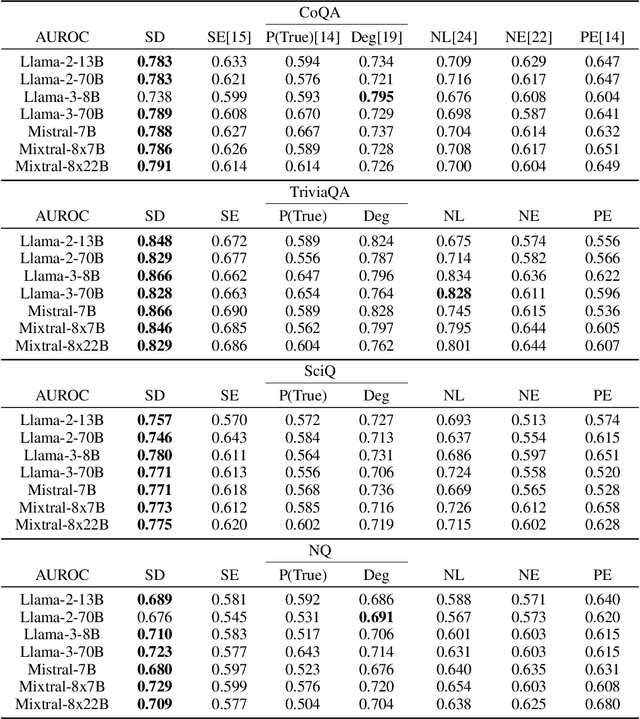

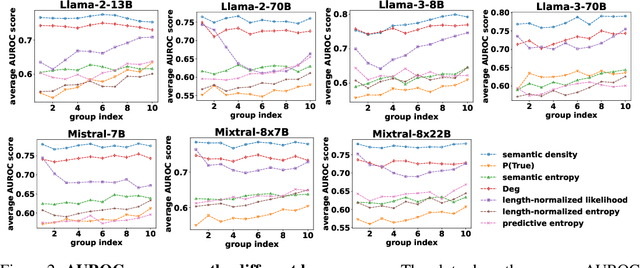
Abstract:With the widespread application of Large Language Models (LLMs) to various domains, concerns regarding the trustworthiness of LLMs in safety-critical scenarios have been raised, due to their unpredictable tendency to hallucinate and generate misinformation. Existing LLMs do not have an inherent functionality to provide the users with an uncertainty metric for each response it generates, making it difficult to evaluate trustworthiness. Although a number of works aim to develop uncertainty quantification methods for LLMs, they have fundamental limitations, such as being restricted to classification tasks, requiring additional training and data, considering only lexical instead of semantic information, and being prompt-wise but not response-wise. A new framework is proposed in this paper to address these issues. Semantic density extracts uncertainty information for each response from a probability distribution perspective in semantic space. It has no restriction on task types and is "off-the-shelf" for new models and tasks. Experiments on seven state-of-the-art LLMs, including the latest Llama 3 and Mixtral-8x22B models, on four free-form question-answering benchmarks demonstrate the superior performance and robustness of semantic density compared to prior approaches.
Shortest Edit Path Crossover: A Theory-driven Solution to the Permutation Problem in Evolutionary Neural Architecture Search
Oct 27, 2022

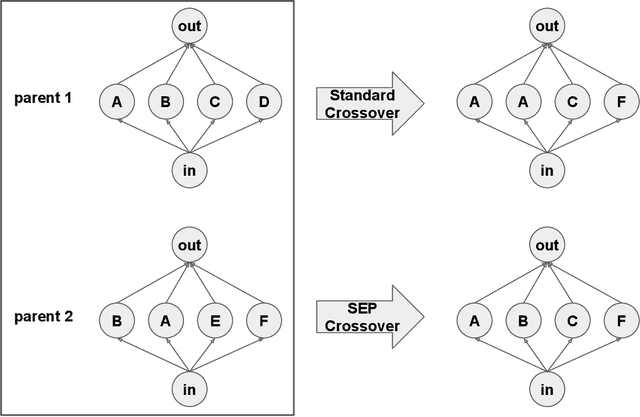

Abstract:Evolutionary algorithms (EAs) have gained attention recently due to their success in neural architecture search (NAS). However, whereas traditional EAs draw much power from crossover operations, most evolutionary NAS methods deploy only mutation operators. The main reason is the permutation problem: The mapping between genotype and phenotype in traditional graph representations is many-to-one, leading to a disruptive effect of standard crossover. This work conducts the first theoretical analysis of the behaviors of crossover and mutation in the NAS context, and proposes a new crossover operator based on the shortest edit path (SEP) in graph space. The SEP crossover is shown to overcome the permutation problem, and as a result, offspring generated by the SEP crossover is theoretically proved to have a better expected improvement in terms of graph edit distance to global optimum, compared to mutation and standard crossover. Experiments further show that the SEP crossover significantly outperforms mutation and standard crossover on three state-of-the-art NAS benchmarks. The SEP crossover therefore allows taking full advantage of evolution in NAS, and potentially other similar design problems as well.
BigDL 2.0: Seamless Scaling of AI Pipelines from Laptops to Distributed Cluster
Apr 03, 2022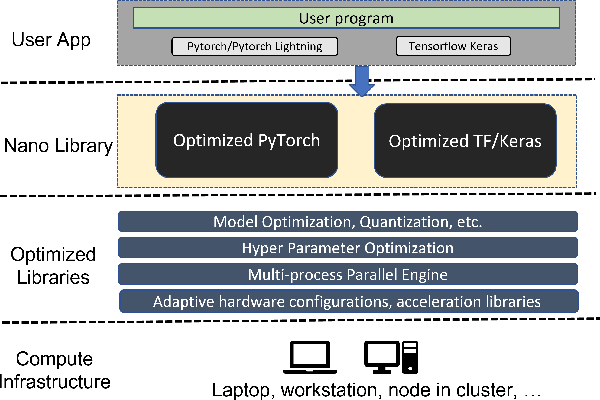
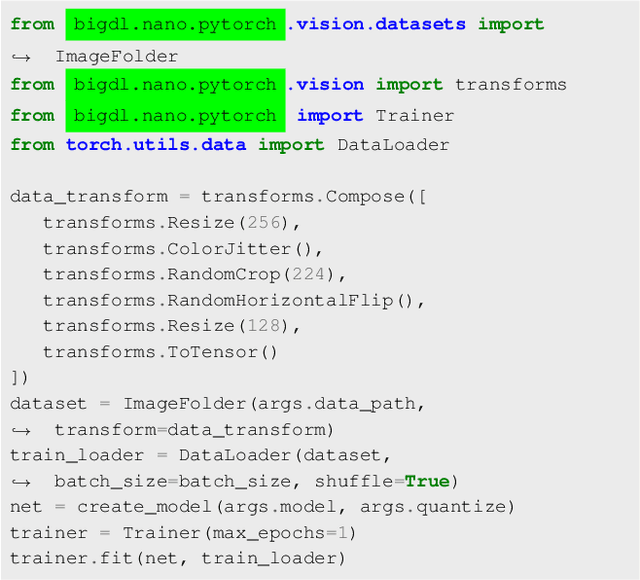
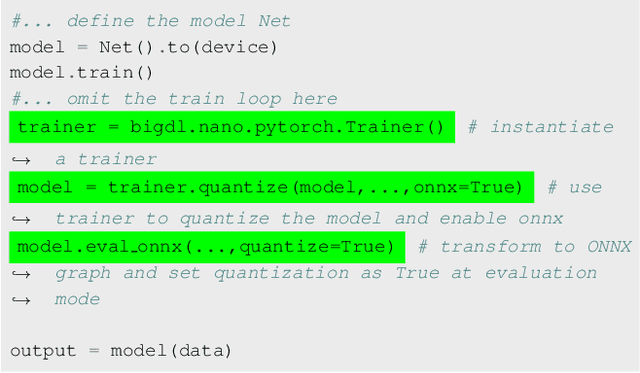
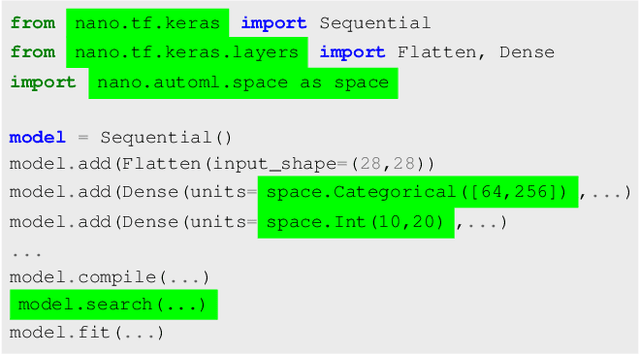
Abstract:Most AI projects start with a Python notebook running on a single laptop; however, one usually needs to go through a mountain of pains to scale it to handle larger dataset (for both experimentation and production deployment). These usually entail many manual and error-prone steps for the data scientists to fully take advantage of the available hardware resources (e.g., SIMD instructions, multi-processing, quantization, memory allocation optimization, data partitioning, distributed computing, etc.). To address this challenge, we have open sourced BigDL 2.0 at https://github.com/intel-analytics/BigDL/ under Apache 2.0 license (combining the original BigDL and Analytics Zoo projects); using BigDL 2.0, users can simply build conventional Python notebooks on their laptops (with possible AutoML support), which can then be transparently accelerated on a single node (with up-to 9.6x speedup in our experiments), and seamlessly scaled out to a large cluster (across several hundreds servers in real-world use cases). BigDL 2.0 has already been adopted by many real-world users (such as Mastercard, Burger King, Inspur, etc.) in production.
Simple Genetic Operators are Universal Approximators of Probability Distributions (and other Advantages of Expressive Encodings)
Feb 19, 2022

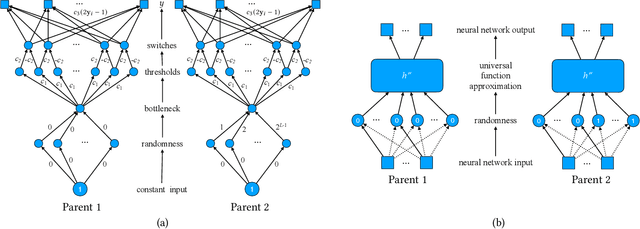

Abstract:This paper characterizes the inherent power of evolutionary algorithms. This power depends on the computational properties of the genetic encoding. With some encodings, two parents recombined with a simple crossover operator can sample from an arbitrary distribution of child phenotypes. Such encodings are termed \emph{expressive encodings} in this paper. Universal function approximators, including popular evolutionary substrates of genetic programming and neural networks, can be used to construct expressive encodings. Remarkably, this approach need not be applied only to domains where the phenotype is a function: Expressivity can be achieved even when optimizing static structures, such as binary vectors. Such simpler settings make it possible to characterize expressive encodings theoretically: Across a variety of test problems, expressive encodings are shown to achieve up to super-exponential convergence speed-ups over the standard direct encoding. The conclusion is that, across evolutionary computation areas as diverse as genetic programming, neuroevolution, genetic algorithms, and theory, expressive encodings can be a key to understanding and realizing the full power of evolution.
 Add to Chrome
Add to Chrome Add to Firefox
Add to Firefox Add to Edge
Add to Edge